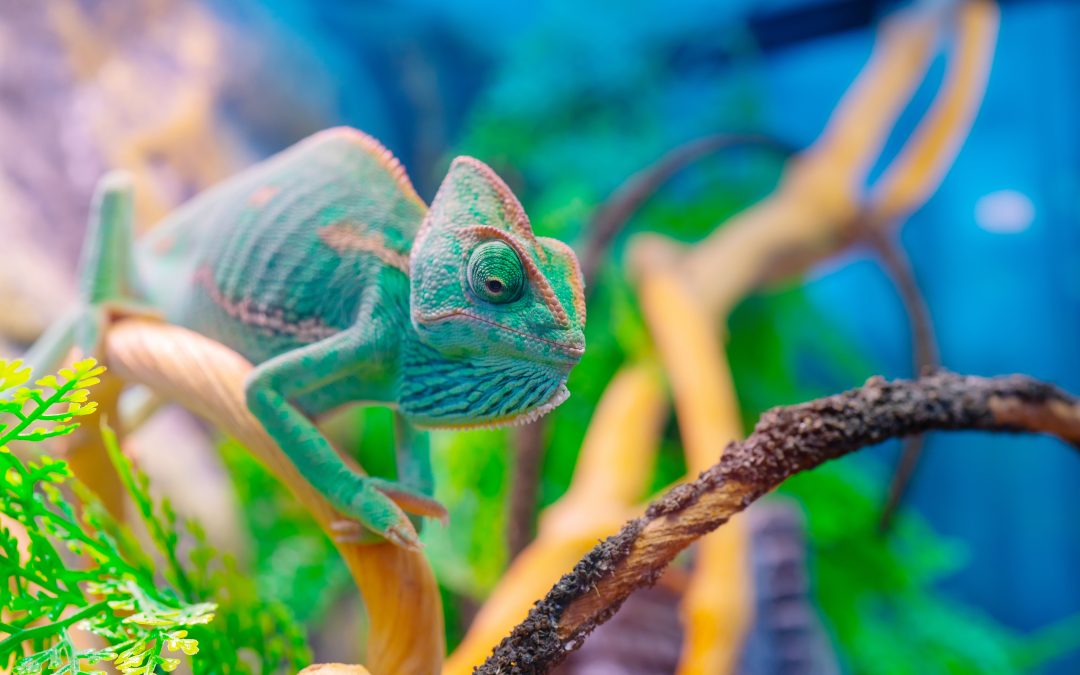Chameleons
Chameleons are very popular as pets. When choosing a pet chameleon, do your research and find out what type of chameleon you want to get. Some are easier to house than others, some are more expensive than others, and some are more readily available than others.
But they require special care:
– Get a chameleon that is a week old or younger. They are easier to handle and have less of an odor than adults.
-The tank should be at least 2 feet wide with plenty of live plants and branches on the ground, but not too many that they can get tangled up in them.
-Plants need to be able to grow fully in order for the chameleon to eat from them – so make sure they are at least 6 inches tall before putting them in the tank.
-The tank needs to stay between 72 and 80 degrees Fahrenheit while it is on the ground
-Chameleons need to be kept at room temperature with an ideal humidity level of 75%.
-They also require ultraviolet light for about 8 hours per day.
-They do not like being handled and prefer not to be teased or taken out of their cage too often.
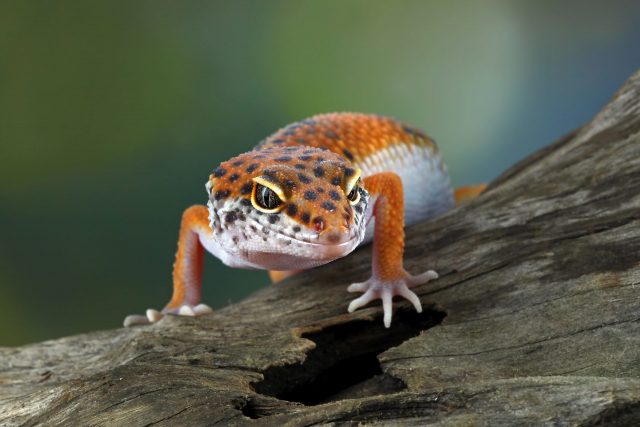
Leopard gecko on a branch
Leopard Geckos
Leopard Geckos make a good pet for people who live in apartments and don’t have time to care for a larger animal. They are cute and docile creatures who can be enjoyed with just the occasional feeding and watering.
You will only need to feed them once every couple of days or every week depending on their size, give them a light misting of water once daily if they’re housed in an enclosure with dry substrate, take care of shedding, and give them around 12 hours of light per day.
If you’re considering getting one, here are some tips on how to properly care for them:
– Leopard geckos only need a 10-20 gallon tank
– They don’t require any special lighting
– You should provide them with a few hiding spots around the enclosure so they can find their preferred hiding spot
– They should have an ample amount of live or fake plants to give them some variety in their surroundings and hide among.

A pet red corn snake
Corn Snakes
Corn snakes can be found in many colors and patterns. The most common pattern is a brown or gray snake with a white underside with black stripes running down its back. Corn snakes also have red or orange blotches on their sides and usually have dark bands across the back of their head which look like eye spots.
Corn snakes are not difficult to take care of, but it is a good idea to make sure that you have the time and money to provide for them.
An important thing to remember when keeping pet snakes is that you can’t just put them in an empty aquarium or tank. You will need to provide them with lots of hiding spaces, branches, rocks, and artificial plants for climbing. It’s also important to feed them live prey like fish, rodents, and insects because they won’t eat dead food.
You should call the humane society first and make sure that it is legal to keep a pet snake in the area. Pet snakes can be bought from pet stores or breeders, but a breeder is recommended because they know more about the animal. A breeder will also have its full pedigree and a health certificate, so there are no diseases present.
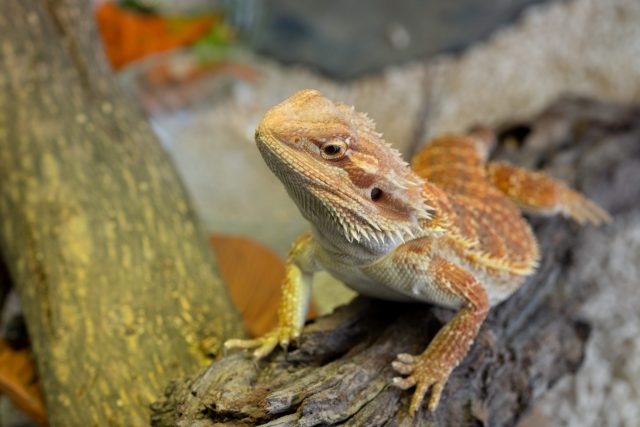
Bearded dragon on a tree limb
Bearded Dragons
Bearded dragons are a popular choice for pet owners, and they even have a bit of personality.
Bearded Dragons make great pets because they are easy to care for, and their natural defense mechanisms make them safer than other lizards. You only need to feed your Bearded Dragon once a day, and they can live up to 15 years with proper care. They can also be handled without being frightened or getting aggressive, so it’s easy to enjoy all of their traits.
It is important to buy a bearded dragon from a breeder or reputable pet store. Bearded dragons are not native to North America, so you want to make sure that you get one that is healthy.
The first step in getting your new pet bearded dragon is deciding how big of an enclosure you need. The size of your enclosure depends on how much space the beardie needs to be able to live comfortably and if they require UV light.
Bearded dragons need a lot of TLC, so make sure you spend time every day with them. They also enjoy climbing, so provide them with an environment that will allow them to do this.
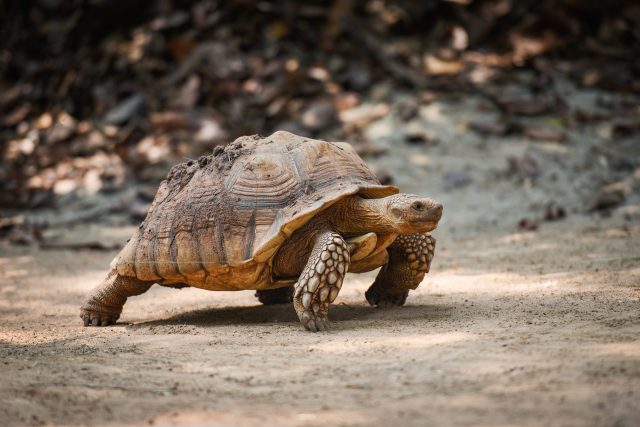
African Sulcata tortoises spurred tortoise / Close up turtle walking – selective focus
African Sulcata Tortoises
African Sulcata tortoises are popular in the pet trade because they can live up to 40-plus years, they grow to be over 200 lbs, and they come in many different colors.
The basics of owning an African Sulcata Tortoise.
● Check your home for a suitable location to keep your tortoise. It needs a dry and sunny area with 60-degree minimum temperatures.
● Consider the cost of food, tank and bedding for your pet. A baby sulcata can cost up to $1,000 while a full-grown tortoise can cost up to $5,000.
● Make sure that you are prepared for its average life span of 40-50 years by setting aside money both now and in the future for vet visits and care.
People with a small backyard or no backyard at all should not consider getting a pet African Sulcata Tortoise. They require outdoor space and the opportunity to roam around.
Check with your local and state authorities for any laws concerning exotic animals. Some states have banned the ownership of these animals due to their size and potential danger to people and other animals in that area.
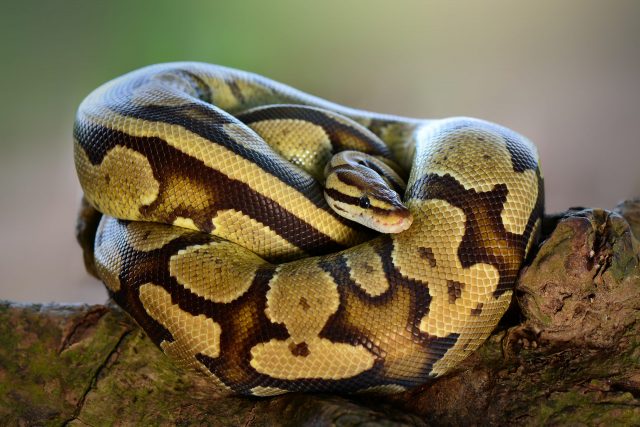
Pet Ball Python
Ball Python
The Ball Python is a large snake that is native to a number of African countries. At maturity, they can grow up to about 4 feet in length. These snakes are called “ball pythons” because when they feel threatened, they curl up into a ball shape.
A ball python that is less than 24 inches long does not require any special care apart from the regular handling and feeding methods. A larger snake needs more care and attention because they will need to be handled more often and fed more frequently.
So how do you know whether you have a baby or full-grown Ball Python? The best way to find out is by using your hands and fingers to measure the circumference of its body at the widest part of its body – usually around its chest area.
Before you get a pet Ball Python, think about the following:
-Do you have enough space for the reptile in your home?
-Do you have the necessary knowledge of veterinarian care for pet Ball Pythons?
-Do you know how to take care of a Ball Python’s needs and wants? -Do you have enough time to dedicate to this new pet?
-Are there any allergies or phobias family members might have to snakes or reptiles that would be put off by having a snake in your home?
-Is it legal and appropriate for your local area to have pet snakes such as ball pythons as neighbors may not be happy about their presence.

Crested gecko in front of white background
Crested Geckos
Crested Geckos are one of the easiest reptiles to care for, making them a great choice for those looking to get a pet lizard. These lizards come from rainforest regions of New Caledonia and are usually no larger than 6 inches in length. They live on the forest floor and eat bugs that crawl on the ground. Crested geckos are called “cresties” for short as well as “biscuit” or “biscuit head” because of their markings and coloring.
This type of gecko is small, but it has a lot of personality! It will spend most of its time high up in trees, which means it needs lots of climbing space indoors. Crested geckos also like to hide in corners and under things.
Crested geckos are relatively low maintenance pets that can be fun for people that want to avoid the more tedious aspects of pet ownership.
What you will need:
– A tank (at least a 20 gallon size)
– A large water dish
– A hide box or two for the animal to hide in when it wants to feel safe and secure. – Substrate (e.g., aspen shavings, bark chips, paper towel)
– Food dish or hide box (depending on what type of food he eats)
– Rocks and decorations for stimulation purposes
– Geckos may not be the best pets for young children. They can bite and they will most likely get scared if children try to grab them.
– These lizards eat insects like crickets and mealworms. You will need to provide your pet with these as well as other live food.

Red-eared turtles. AKA Pond Slider Trachemys scripta elegans sunbathes on a rock in the water. Selective focus.
Red-Eared Sliders
Red-Eared Sliders are the most popular water turtles in the United States. They are easy to care for, and they have a great personality. It can be challenging, though, to know where to get your pet Red-Eared Slider. Here are some tips for having them as pets.
1. Red-Eared Sliders are freshwater turtles, which means they need to live in a tank of water that is kept clean at all times. They also need to be able to bury themselves in moist sand or dirt, so a tank with an attached water filter for the water is recommended.
2. You will also have to feed your turtle every day, and you should only feed it live food as it needs the exercise from hunting for its food and the nutrients from living prey.
3. It is important to note that Red-Eared Sliders require a lot of space in their tanks and can grow up to 12 inches long, so an 8 gallon tank may not be large enough.
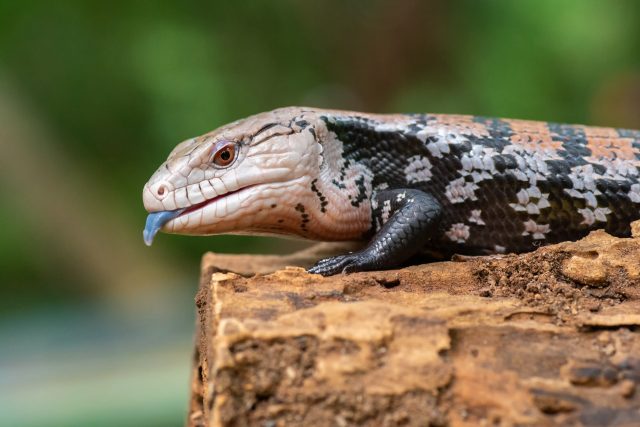
Blue-Tongued Skink
Blue-Tongued Skink
The blue-tongued skink is a type of lizard that is available at many pet stores. But before buying one it is important to know what to expect and how to take care of them. They are easy to care for but require a lot of attention from their owners so they can thrive and live a happy life.
It is important to know that pet skinks are not easily domesticated and that they are not legal in every state. They need a high-quality diet of live insects and worms, which can become expensive, depending on the area where you live. There is a lot of maintenance involved in this process. They can emit a foul odor if they have been kept wet for too long, which can be nauseating to some people. Skinks also need to be kept warm and dry, which may require some additional tools like heat mats or heating pads.
The first step to take in getting a pet Blue-tongued skink is to make sure you have time for them. You should also consider the care these animals require. The Blue-tongued skink is an exotic animal that needs specialized care. They are not the most friendly creatures either and can be difficult to handle.
Eastern Box Turles
Eastern box turtles are a good pet to have because they eat less food, are relatively easy to maintain, and are easy to care for.
Turtles are also very sensitive creatures, which means they need their own space and time away from people, especially when they are feeling vulnerable and scared after hibernation or molting season. It is important for turtles to be able to rely on their owner as a safe place when they need it the most and this can only happen if the owner remembers these tips during all times of the year.
– Eastern box turtles eat less food than other pet reptiles.
– The feeding process of these pets is also relatively straightforward.
– They need a habitat that has a basking light and should be setup before purchase.
– Eastern box turtles are not aggressive creatures but will defend themselves if provoked or scared by sudden movements and abrupt changes in their environment.

